Of all the boisterous weekends at notoriously boisterous Lake of the Ozarks in central Missouri, this one out-louds them all. Rumbles bounce off the high rock walls on both sides of the water, emanating from Bajas and Fountains and Checkmates and Eliminators muscling one at a time down a straight-line race course. It’s as if they’re pleading for attention from the 30,000 spectators at the annual Lake of the Ozarks Shootout, billed as the largest unsanctioned boat race in the United States. Then the noise softens. A 28-foot Powertoon Xtreme with a 430-horse MerCruiser 8.2-liter Magnum HO eases toward the course’s threshold, not exactly a greyhound behind the gate, but more of an unusually athletic Saint Bernard. A pontoon! Instead of performance-style bolsters and chicken straps on board, there are couches and drink holders — lots of them. At the helm, 60-year-old Carolyn Dorris, wife of PlayCraft founder Jim Dorris, massages the throttle. The spectators have turned their eyes in unison to watch. This is what they’ve been waiting for.
Go ahead and laugh. Just don’t roll your eyes or you might lose sight of the reasons why this year’s Ozarks Shootout caps what could arguably be called “the decade of the pontoon.”
“We’ve moved so fast the past 10 years that some people still don’t understand the ‘wow’ factor that’s going on,” says JC Manufacturing president Kim Cripe.
Carolyn Dorris’ boat was rigged to run 60 to 65 mph, which nowadays is just a tad faster than pedestrian for pontoons. There’s no rub to that top-end number either. The boat came out of production to be sold at retail. It just happened to get a pretty cool trial run along the way. For sheer speed, consider the 2009 Shootout, where an older-model Odyssey with twin 300XS outboards and a PlayCraft with a blown 540 pumping 950 horsepower raised each other all afternoon until they both showed their final hands at 91 mph. Pontoons! In the fall of 2004, this magazine’s test team clocked a 32-foot, 10-foot-wide, 7,800-pound PlayCraft Megatoon powered with twin MerCruiser 496 Mag HOs at 67.1 mph. This on a boat with a 146-gallon fuel capacity and seating for 20.
“What I like is to cruise down the lake and have a guy in a big powerboat come alongside,” Jim Dorris says. “He starts pulling away; I stay with him. He pushes the throttle; I push down a little. He doesn’t want to be shown up, so now he crams it down hard, and I blow by him. He’s working it. I’m just relaxing and waving.”
Dorris triggered the concept of performance pontoons for the masses when he first entered the Shootout in 1995 with a newly engineered Hydrotoon (later to be called Powertoon) carrying a small-block 350, extra cross members for rigidity in the deck and, more importantly, mysterious Rac-R-Fins welded to the tubes to help them lift and go. The boat went 46.8 mph.
“It wasn’t real fast by today’s standards,” Dorris says, “but we got front page coverage in the local paper even though there were million-dollar boats and speeds well over 100 miles per hour. People said, ‘What’s a pontoon doing out here?’ Look what it’s developed into.”
Dorris says at least 50 percent of the PlayCrafts built now are performance-oriented Powertoons, with their long center tubes, splash fins forward, double-plated aluminum in high-stress areas and those Rac-R-Fins. Manitou Boats gives credit to its sport handling package (SHP) for a recent run of customer satisfaction awards from J.D. Power. Most of the top builders, including Premier, Manitou and South Bay (formerly Odyssey), say 30 to 40 percent of their boat buyers are using pontoons as their primary do-everything performance rides instead of as second boats for puttering and cocktail houring.
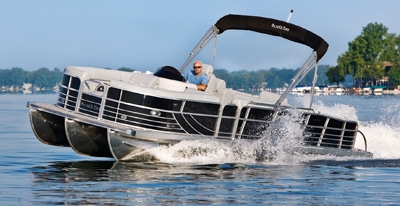
The performance pontoon era didn’t take flight right away though. In the late 1990s, more than 90 percent of pontoons sold were still the traditional two-tube variety, with horsepower averaging 25 to 50, one-third of today’s power. The round tubes themselves were typically 21 inches in diameter, limiting their flotation and, thus, a boat’s maximum rated horsepower. In Y2K, Odyssey’s engineers, experimenting with ways to change the landscape, perfected a 23-inch-diameter tube, which later would grow to 25 inches. They welded strips of 1.5-inch angled aluminum to the tubes — lifting strakes. On the underside of the deck they crafted aluminum sheets to cover up the cross members and fasteners — maybe not the first to do so, but this version was curved into radiused underbellies. Then, along the St. Joseph River near Elkhart, Indiana, with local media and radar guns on the scene, the first Odyssey with twin outboards (Evinrude 250s) reached 81 mph. A pontoon!
“Nobody expected it,” says South Bay’s Guy Vidmar, who’s been with the company since it was known as Odyssey. “The whole idea was like fitting a square peg into a round hole. We had to rethink everything prior to that run.”
The strakes worked. Instead of the tubes forcing their way through the water like half-submerged torpedoes, the front ends rose above the water and reduced the amount of wetted surface. The underbellies acted like tunnels and allowed a seamless flow of water and air between the tubes and out the back, turning drag into positive hydrodynamics.
“You can see the water coming out the back like you see behind a jet boat,” says Mark Zerbst, owner of Dockside Marine in Glennie, Michigan, near Lake Huron.
Zerbst, now an Aqua Patio dealer, has helped turn the northeast region of Michigan into high-performance pontoon turf. In 2001 he brought a showstopping 300 hp V-8 stern-drive model to the fiberglass boating fraternity on the Au Sable River, drawing stares. Soon after, he was seen tooling across Saginaw Bay at 60 mph on the strength of a 300 hp outboard and casually sipping a cold drink.
“I’m just cranking by these runabout guys, and I’m carrying 10 to 12 people,” Zerbst says. “The whole idea was to get the boats in front of other boaters and create a buzz. Once they saw it, they got it. I can tell you that the majority of those people converted from fiberglass to some type of performance pontoon.”
So, production-model pontoons, still rectangular and aluminum-centric, have become capable of highway speeds. But it’s like the kids who shake and kick the can of Dr. Pepper until it explodes. Cool! OK. Now what?
If there’s such a thing as a silver bullet in the development of performance pontoons, it’s about 25 feet long: the center tube. Builders were experimenting with three- and even four-tube pontoons 40 years ago, but they had no more functionality than log barges. Godfrey, Harris Kayot and Sylvan all had stern-drive pontoons but hadn’t figured out how to merge them with the bulk of a third tube.
Kim Cripe’s dad, John Cripe, visualized a center tube a little longer in the bow and solid enough to hold the inboard/outboard at the stern. Because JC’s tubes were U-shaped instead of round, he wouldn’t need a separate motor pod. The idea was so loaded with potential that he trademarked the name TriToon five years before anyone outside his family believed.
“We went down to Mercury’s test site in Florida with our first outboard version of the classic TriToon in 1986,” Kim says. “The Merc guys were reluctant to even talk with us before we got there. But the minute we slapped a motor on and ran it up to 40 miles per hour, their techs got excited. They basically pushed us out of the way and got serious about testing props, using the radar gun, putting out performance bulletins. It was a pink elephant.”
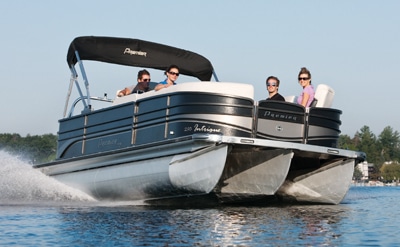
The elephant is now in the boathouse, permanently. It goes by monikers like PTX, SHP, ESP and RPT. Ever since the center tube proved to be the cornerstone for speed and handling (because of higher flotation and its application as a keel), builders have gone to bending, expanding, flattening, shaping, lowering, widening and squeezing it for all it’s worth, literally.
In Wyoming, Minnesota, Premier Marine owner Bob Menne charged his in-house fiberglass expert, Fred Cotey, with developing an aluminum stern-drive housing in the late 1990s.
“About all he said was, ‘make it work,’” says Cotey, who in the previous decades had worked for HydroStream, designing pad-bottom speedboats.
To hold a V-8, Cotey had the crazy notion to widen the center tube to 36 inches. It would taper toward the bottom and settle into a 12-inch flat surface. Called the PTX, not only does the tube easily hold the motor, but in conjunction with the 23-inch outer tubes it allows the boat to turn quickly enough to run a buoy course — we’ve done it.
Manitou’s SHP uses similar physics — a 27-inch center tube, mounted five inches lower than the 23-inch outers to create a deeper centerline. The boat can make buttonhook turns when the wheel is cranked over hard at 40 mph — done that, too, and learned to hold on tight. “People are shocked to see what we can do,” says Dave Curtis, Manitou’s vice president of operations. “It isn’t just trying to look like a sport boat anymore. It is a sport boat.”
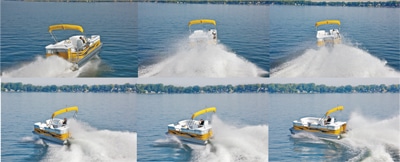
Jim Dorris can’t believe what we’re talking about. Fifteen years does not seem like 53.2 mph ago. There he was in 1995, clocking 46.8 mph and slapping the steering wheel as if he just told the funniest joke ever heard. A pontoon!
And now here he is, being told that the mad scientists at South Bay are reportedly closing in on the 100 mph mark. Dorris says it’s “obtainable.” There’s something in his voice that begs a question.
“How close are you?” Dorris is asked.
Dorris doesn’t even pause. “I’m not saying.”
He’ll only say that he’s been toying with a two-tube PlayCraft that runs faster than 70 mph with twin 383 Stroker Scorpions. Two tubes?
“This whole performance thing isn’t just horsepower,” he says. “For us it’s those Rac-R-Fins.”
When asked to expound on the fins, Dorris gives a two-beat laugh.
“The secret’s in the water. As far as I’m concerned, it stays there.”
And with that he laughs out loud. It’s as boisterous a laugh as you’ve ever heard.
Alphabet Power
The middle tube on a pontoon boat does not in itself add speed. Only horsepower can do that. But the extra tube does add possibilities. Here’s a breakdown of how nine builders configure theirs, and how well they work.** **
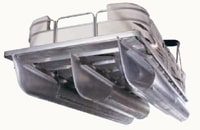
TT (AQUA PATIO)
What It Is: Middle tube is 27 inches in diameter, flanked by 25-inch outer tubes, with lifting strakes on the inside. Middle tube is slightly shorter to reduce overall weight.
Our Test: With a MerCruiser 350 Mag powering a 26-foot-8.5-inch 240 Elite, top speed was 44.1 mph; time to 30 mph was 9.2 seconds.

ESP (BENNINGTON)
What It Is: The center tube is elliptical (wider than it is tall by seven inches), which closes the gap between it and the outer tubes. It also adds buoyancy, allowing for more horsepower.
Our Test: With a 350 hp Yamaha powering a 25-foot QXi, top speed was 47.4 mph; time to 30 mph was 5.8 seconds.

PTX (PREMIER)
What It Is: A 36-inch-wide center tube with a taper into a flat planing surface on the bottom. That and lifting strakes on the outer tubes enhance the handling.
Our Test: With twin 300 hp Suzukis powering a 31-foot-long, 10-foot-wide Boundary Waters, top speed was 51 mph; time to 30 mph was 4.0 seconds.

RAC-R-FINS (PLAYCRAFT)
What It Is: PlayCraft’s own version of lifting strakes is used on big U-shaped tubes to raise the front part of the tubes and dramatically reduce water friction on them.
Our Test: With twin MerCruiser 496 Mag HOs powering a 32-foot-long, 10-foot-wide Megatoon, top speed was 67.1 mph; time to 30 mph was 6.0 seconds.

SHP (MANITOU)
What It Is: The 27-inch center tube is mounted 5.25 inches deeper than the 23-inch outers, allowing for banking in turns and improved maneuverability overall.
Our Test: With a 225 hp Yamaha powering a 22-foot X-plode, top speed was 49.3 mph; time to 30 mph was 7.7 seconds.
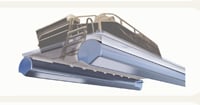
RPT (SYLVAN)
What It Is: Top two-thirds of the tube is round, but toward the bottom the shape cuts in and forms a V, reducing the amount of mass moving through the water.
Our Test: With a 200 hp Evinrude HO powering a 22-foot Signature, top speed was 45 mph; time to 30 mph was 5.7 seconds.

TRIFECTA (SOUTH BAY)
What It Is: The engineers haven’t tinkered too much with the success under the Odyssey name — angled lifting strakes and a radiused underbelly for hydrodynamics.
Our Test: With a MerCruiser 8.1-liter 496 Mag HO powering a 25-foot-9-inch 925 CTT, top speed was 58.5 mph; time to 30 mph was 6.7 seconds.
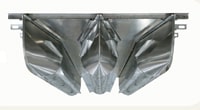
TRITOON (JC)
What It Is: Three U-shaped tubes, 23 inches at the top, 24 inches in the center and radiused toward the bottom, with strakes on both sides of the center tube, and on the inside of the outers.
Our Test: With a MerCruiser 5.0-liter MPI powering a 24-foot TriToon, top speed was 40 mph and the boat held 23 mph in a hard turn.

XP3 (TRACKER)
What It Is: All tubes are 26 inches in diameter, with performance strakes on both sides of the inner tube and on the inside of both outers. The middle tube is set back a bit to modify bow lift and help in turns.
Our Test: With a 200 hp Mercury Verado powering a 26-foot-11-inch Regency 25 XP3, top speed was close to 40 mph.









